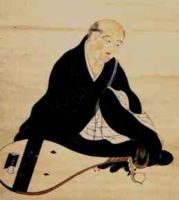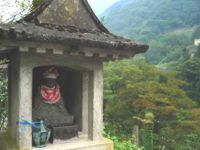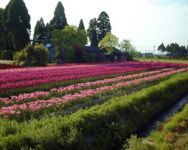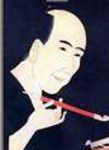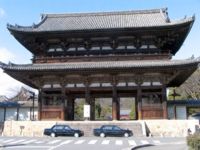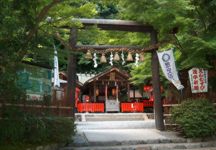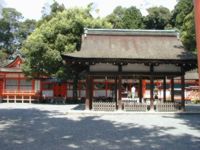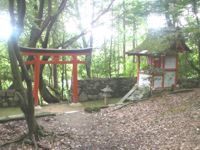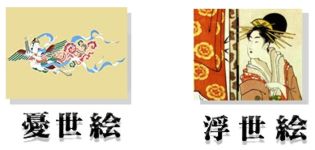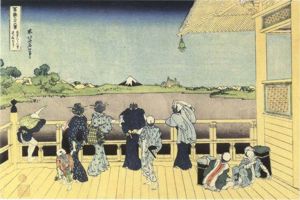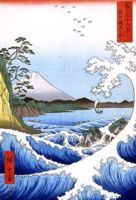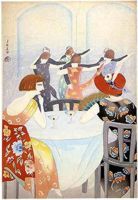| Makoto | Hagakure | Ukiyo | Seppuku | Zen | Kamikaze | Yakuza |
| Shinto | Tatenokai | Tanaka | Jibakutai | Jieitai | Mishima | Chu Hsi |
U K I Y O
 |
This might have been one of three Japanese words that are clogging the internet since 2000 (the other two are 'samurai' and 'bushido'). And it might also have been a rep of one of the most often misunderstood Japanese concepts ever. The Japanese imported the concept of 'ukiyo' (without the name) from China in the 6th century (see History of Japan). It was part of the basix of Buddhism, which the Japanese modified to reconcile it with their 'national temperament', Shintoism. What couldn't fit in was discarded, and what didn't interest the samurai was stashed at the deepest recesses of monasteries. |
Then what the heck is 'ukiyo'?
'Ukiyo' is a little word that conjures up the entire worldview of Buddhism, which is this: human existence, AKA life, is too temporary to get yourself attached to it so much. All your so-called 'life' -- your wife, your kids, your job, yout boss, your dad, your reputation, your fame, your shame, your taxes and your laundry, are all nothing but lumber on your fragile little boat you dub 'existence'; what a fool you would be if you insist that they are more valuable than dust in the wind (as in the old ballad by the band of 1970's called 'Kansas'). In other words, 'ukiyo' is 'the fleeting world'. This world. If you think that to live forever is a bliss, then you might translate 'ukiyo' into 'the world of sorrow', because the temporariness and meaninglessness of everything would be saddening to you then. Yet, Buddhism is too full of commonsense that it never really asks people to shove all worldly (hence, meaningless) attachments into the bulk folder, since this is against human nature. It only asks you to keep remembering the existential fact that your existence is meaningless, and that you ain't gonna live longer than another 20 years, so you should mind better stuff than mortgage and sex and Mexican food, or else you'll get reborn as George W. Bush.
Like all religious teachings, the thing that 'ukiyo' is can't really be put down into words; and like all other systems of belief, Buddhism relies on redundancy to sink it into your mind rather than to make you see what it is via logic. But since I'm only ecclesiastic if my cats were all Popes, I can hereby ignore the usual method of hazy wordiness and try to bring you what 'ukiyo' is another way. In this, meet Kamo Chomei and Yoshida Kenko, two of the most lovable Japanese classical writers, both of which were Buddhists, and both spent their lives gazing at 'ukiyo' and wondering why the rest of the world never dug it. Kamo Chomei's everlasting tome is titled Hõjõki, written around 1299. It has been routinely anglicized into a rather unappetizing and unromantic line: The Ten Foot Square Hut. That's the size of the Japanese tea-room, or more exactly the size of the mats; and the size of Kamo's hut that he built on the Central Mountain (Toyama). Before getting himself into this solitaire, Kamo Chomei belonged to the Shinto shrine of Kamo, Kyoto. That's why his name is like that. The second is his Buddhist name, so actually 'Kamo Chomei' is not a name at all (sorry if this confuses you; see the Japanese names & their meanings at another page). Anyway, Kamo's dad and grandfather and all were Abbots of the shrine, so he understandably thought his turn would come one day soon. Only it didn't. It was someone else who was put in that position. Disgusted at the way things went, Kamo resigned from the shrine, climbed the mountain, and lived as a hermit, and turned more into Buddhism (like I said earlier, virtually everybody in Japan is Shintoist and Buddhist at once).
Yoshida Kenko wrote his masterpiece Tsurezuregusa, AKA 'The Grass of Idleness', between 1330 and 1332, and it appeared in circulation since 1431. The 'Yoshida' part is not his clan; it was a street name where his house was in Kyoto. His name before taking up the Buddhist name is Urabe Kaneyoshi ('Urabe' is his clan, one of the oldest samurai clans of Japan which always dabbled in religious matters). Like Kamo's family, Yoshida's was Shinto priests, too, and he inherited the job. But Yoshida was more interested in poetry than ancient rites. So he sort of neglected ecclesiastical duties for poems. Fortunately this wasn't fruitless. By word of mouth his reputation as a local poet reached the Imperial Palace and he was given access to it by Emperor Uda II (Go-Uda in Japanese). But in 1324 the Emperor died. Yoshida packed up and left the Palace, quite right in time, so that he wasn't to get involved in the succession battles. But that doesn't mean he was super-loyal to his former patron or something. To Yoshida, all rulers were the same, and he had no political preference, so he made obeisace to Emperor Daigo II, as well as to the Emperor's nemesis Ashikaga Takauji, like an ideal citizen. Though impolitical to the bones, Yoshida was known to have been rather 'close' with the Kono clan, whose short-tempered chief was his pupil (Yoshida taught poetry-writing to samurais just for the money). That was a churning period of the Japanese history, where two equally legitimate Emperors set themselves up, and warlords behind them were busy annihilating each other, until finally Ashikaga Takauji made himself the first Shogun of his clan and put the nation into 200 hundred years of familiarity with interclan wars (this shogunate was the one supposedly in charge of Japan when the 'Warring States period' or Sengoku started). When Yoshida wrote his pieces (literally; they were scribbled on a stack of scraps of paper), Japan lost one of its truest heroes and role models of the samurai class of all times, Kusunoki Masashige (see the Bushido Heroes page). But he, predictably, didn't even consider it worth recording or worth contemplating about. That's where Yoshida's writing differs from that of Kamo's -- the two men, equally taking up the subject of 'ukiyo', were as different in personality as in their outward appearances. Kamo lived the ideal hermit's life -- away from everything and everybody, up above the traps of human ambition and lust and passion. Yoshida lived at the center of everything and everybody. Kamo wrote about the empire's conditions, wars and politics; Yoshida ignored all those. Kamo was 'more Buddhist' in tones -- he was kind of melancholic, like all writers of classical tomes seem to be. Yoshida was one of the most cheerful men around, who was always invited to poetry events mostly for his presence that lit up the sombre atmosphere. Kamo dug as deep as he could for the roots of things, while Yoshida dealt with things above the ground (mentally and literally alike) for the fruits. Kamo only got into pilgrimage, Yoshida brushed shoulders with Shinto and Buddhist priests all over Kyoto, especially those at the Ninna temple and Nono shrine. These places gave him real-life materials (such as the habits of eccentric priests) to be written. Those are why I choose them to dish out 'ukiyo' here for you; because Kamo is a recluse and Yoshida a socialite, Kamo was political and Yoshida was impolitical. Here's 'ukiyo' from the two poles of real lives:
"Born in the morning and dead by night, that's the way man goes, since the beginning of time, in an endless cycle. And does he know where he came from, or where he will go? Can he give a reason for wasting so much money and energy to build his house? Can he answer if you ask him why it makes him think that he is happy? Both the man and the house are morning mist, which is bound to evaporate into nothing once the sun rises. You may say the dew will come again tomorrow, but it's not the same dew of today's, is it? And what makes you so sure that you will be there tomorrow to see it?" "Whenever there is a great calamity, we hear people claiming awareness of the impermanence of life and how vain attachment to worldly things, persons and matters is. But calamities pass in time. When they subside, all thoughts of impermanence are instantly abandoned. This is to be repeated endlessly." "I think all the problems in life come from this fleeting evanescent of man and his things. If you possess some wealth, you are in a constant worry about the safety of the wealth and yourself and your family. If you have nothing, you are dying with envy. If you show compassion to others, they use you, so you feel resentment everyday and yet the burden put on you is not lessening. If you don't show compassion, they say you are a brute, and you hate them for it everyday, and you think up schemes of how to change their perception without losing anything, thus you can't rest. And you call this 'life'? Calamities pass away in time, so do worries, but so do you."
"If human beings were never to fade away like the dew and never to vanish like the smoke, but to linger forever in this world, how things would lose their power to move us! Things are valuable to us precisely because they are so fragile, temporary, impermanent. Think about all creatures: is there any that lives as long as humans? A fly born in the morning never sees sunset, cicadas have a livelong summer and never know what spring or autumn is. A thousand years is a single night's dream." "Times change and things disappear, joy and sorrow come and go, a city turns into an uninhabited moor, a house which remains standing is occupied by different tenants. Why bother planning for the future that you will never know? Do you see how gravestones are covered with moss and crumble slowly to the ground where they came from? Even the last memento of the dead, too, will vanish." "Maybe we would want to leave behind a glorious reputation that will not perish through the ages, to be remembered as a brave man, a wise man, or a man of a great achievement. But you better be careful when this enters your mind. What we mean by 'glorious reputation' is only the approbation of other people. Those who praise us, and those who abuse us, won't live for long; so before whom shall we feel exalted or ashamed? A craving after fame is next most foolish after a craving for wealth and ranks." "Whenever I witness the things people do in their struggle to 'get ahead', I am reminded of someone who builds a snowman, adorns it with diamonds and gold, and then builds a hall to diplay it in. Does this make any sense? Then why should the struggle for 'success' make sense?" "The poet Fujiwara Kin'yo (d. 1301) had a brother, the High Priest Fujiwara Ryogaku (d. 1305). At the yard of his monastery, Ryogaku planted a nettle-tree. After that, people called him 'Nettle High Priest'. "That's outrageous!" shouted the angry Ryogaku. He cut the tree down, leaving only a stump on the ground. From then on, people called him 'Stump High Priest'. Angrier than before, Ryogoku dug the stump and roots, and threw them away. A hole was all that was left. Now people called him 'Ditch High Priest'."
You've got to be kidding if you're still asking this question. At a glance the 'ukiyo' seems to be an antithesis of Shintoism (and Confucianism) -- your dad and your mom died, what is that to you? Your boss died, so what? You, too, will pass away; what will that matter to anyone? Why the fuss around filial piety and ancestral worship? But somehow 'ukiyo' even fits into the Bushido and the other way around, precisely because "everyone dies". With the consciousness that life is fleeting and flimsy, the samurai's mind was at ease whatever he did -- killing, winning, losing, getting killed. Like the lyrics to Oda Nobunaga's favorite song and dance 'Atsumori' (click here for story and pictures) that said:
That, too, is 'ukiyo'. So because life is such, what remains is not how to live, but how to die (see the page on the Shield Society for a complete account of this). 'Ukiyo' isn't just manifested in samurai-related stuff. See the traditional Japanese architecture (click here) -- the paper walls are 'ukiyo' in broad daylight. Paper lanterns are 'ukiyo'. Wooden stuff are 'ukiyo'. Origami is 'ukiyo'. Paper dolls are 'ukiyo'. And so forth. It's impossible that anyone could have missed the glaring fact that Japan, in general, has been opting for materials that won't last (that they somehow do last is accidental). The flutter of banners bearing family crests are 'ukiyo' -- it needs no extra grey cells in the head to see that it denotes some radically different worldview from the European coat of arms that they invariably forged of metal.
Now the thing you've been thinking all along: what the heck does the 'ukiyo' above have anything to do with woodblock prints? The letter '-e' in 'ukiyo-e' means 'picture'. So the prints, which have been such a rage lately in your world, are 'pictures of ukiyo'. Only in this case the 'ukiyo' is another 'ukiyo'. This 'ukiyo' was born during the reign of the Tokugawa shogunate, in 18th century. And it has been most often translated into this meaningless English: 'the floating world'. Not this world. It's another world; the world of the Japanese people who had much money and fake prestige, the world of the Tokugawas between 1700 and 1868. The world of degradation of the female entertainers into caterers of sparetime escapism, the world of open prostitution of both (or three) sexes, the world whose sense of beauty and fashion was dictated by cross-dressing actors. (See the History of Japanese Clothes and History of Japanese Geisha). It was a world of artificiality, superficiality, frivolity, and such -- a world that existed in daydreams and not of reality, a world where trivia was taken seriously.
Subjects of the 'ukiyo-e' were various, but the most prominent were nature, geisha and actors -- like in computer wallpapers today. Most explanations about these 'pictures of the floating world' always separate the 'ukiyo' depicted in them from the Buddhist 'ukiyo' that I have so wordily pasted earlier. But actually the two 'ukiyo's are not that neatly severed from each other, conceptually-speaking.
No matter what is portrayed in the prints, those are temporary. See the specimens above. Hokusai's crowd would disperse and disappear into their petty meaningless lives right after the sun can be seen no more on Mount Fuji far away from the dock. The wooden construxion itself would crumble. The sea and mountain and forest would change, and the dance would end, the dresses turn into rags, and all that live inside the prints are on their irrevocable way to death. Such a reading makes the floating world another way of calling the fleeting world. And that, actually, was what intended by whoever coined the term that was made to be homophonic with the other 'ukiyo'. |
| Previous
Page: The Bushido of 1970 |
NEW Black Dragon Society |
Next
Page: Jibakutai & Kamikaze |
|
Site & Rap © 1996, 1997, 1998, 1999, 2000, 2001, 2002, 2003, 2004, 2005, 2006 Nina Wilhemina
All rights reserved. Every borrowed image at this site is put for non-profit educational purposes only.
HOME
 LINKS
LINKS
 CONTACT
CONTACT
 CREDITS
CREDITS
 COMMENTS
COMMENTS
Sources tapped for this page: Nihon Shakai no Kazoku teki Kosei (Tokyo: 1948); Kono Shozo, Kokumin Dotoku Yoron (Tokyo: 1935); Anesaki Masaharu, Nichiren, the Buddhist Prophet (Cambridge, Mass.: Harvard University Press, 1916); Robert Cornell Armstrong, Light from the East, Studies of Japanese Confucianism (University of Toronto, Canada, 1914); Sasama Yoshihiko, Nihon kassen zuten (Yuzankaku, 1997); William Aston, Shinto: The Way of the Gods (London: Longmans, Green, 1905); Ruth Benedict, The Chrysanthemum and the Sword (Boston: Houghton Mifflin, 1946); Charles Eliot, Japanese Buddhism (London, 1935); Futaki Kenichi, Chuusei buke no saho (Yoshikawa Kobunkan, 1999); Kiyooka Eichii, The Autobiography of Fukuzawa Yukichi (Tokyo, Hokuseido Press, 1934); Konno Nobuo, Kamakura bushi monogatari (Kawade shobo shinsha, 1997); Nukariya Kaiten, The Religion of the Samurai (London: Luzac, 1913); A.L. Sadler, The Beginner's Book of Bushido by Daidoji Yuzan (Tokyo: Kokusai Bunka Shinkokai, 1941); A.L. Sadler, The Makers of Modern Japan (Tokyo: Tuttle, 1978); Satomi Kishio, Nichirenism and the Japanese National Principles (NY: Dutton, 1924); Suzuki D.T., Zen Buddhism and Its Influence on Japanese Culture (Kyoto: The Eastern Buddhist Society, 1938); Henri Van Straelen, Yoshida Shoin (Leiden: Brill, 1952); Robert Bellah, Tokugawa Religion; Sato Hiroaki, Legends of the Samurai (Overlook Press, 1995); Masaaki Takahashi, Bushi no seiritsu: Bushizo no soshutsu (Tokyo: Tokyo daigaku, 1999); Stephen Turnbull, Samurai Warlords (London: Blandford Publishing, 1992); Paul Akamatsu, Meiji 1868, Revolution and Counter-Revolution (Allen & Unwin, 1972); Nitobe Inazo, Bushido, The Soul of Japan (Tokyo: Tuttle, 1970); Paul Varley and Ivan Morris, The Samurai (Weidenfeld, 1970); Inoguchi and Nakajima, The Divine Wind: Japanese Kamikaze Force in World War II (Hutchinson, 1959), Seki Yukihiko, Bushi no tanjo (Tokyo: NHK, 2000); Amino Yoshihiko, ed. Edojidai no mikataga kawaruho (Tokyo: Yosensha, 1998). |
